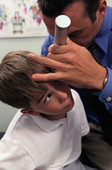New Ear Tube Device Helps Treat Infections Faster
Stainless steel rod reduces time of anesthesia, number of instruments inserted into canal
|
E-mail this article
Subscribe to news
Printer friendly version
|

(SOURCE: University of Virginia, news release, June 16, 2008)
WEDNESDAY, July 2 (HealthDay News) -- A new device meant to make surgical treatment of ear infections safer and faster has been developed by a University of Virginia team.
The device, which combines three of the tools used in the surgical implantation of ear ventilation tubes, has shown promising results in clinical trials.
Each year in the United States, about 2.2 million children need to have tubes implanted for the treatment of chronic ear infections (otitis media) with effusion. The tubes are inserted to relieve pressure and fluid build-up.
"Currently, the procedure is tedious," team co-leader Shayn Peirce-Cottler, an assistant professor of biomedical engineering at the university's School of Engineering and Applied Science, said in a prepared statement.
"Small tubes two to three millimeters in diameter are inserted using four different instruments. The new insertion device facilitates safer, easier insertion. It reduces the time of anesthesia and reduces the number of instruments inserted into the ear canal, which, in turn, reduces the risks for the patient," Peirce-Cottler said.
The new stainless steel device consists of hollow rod with a collar that holds the ear tube in place. This allows the surgeon to apply force to insert the tube with one motion.
"The more times that you put an instrument in and out of the ear canal, the greater the risk of damage to surrounding structures, the wall of the ear canal, or even the tympanic membrane," team co-leader Dr. Bradley Kesser, an ear-nose-throat surgeon at the University of Virginia Health System, said in a prepared statement.
"The skin of the ear canal is some of the thinnest skin in all of the body, so one little touch on this skin, and it starts to bleed. If you have bleeding in the ear canal, you can't see anything. So then, you have to remove the blood and get a clear surgical field before you can safely put the tube in," Kesser explained.
More information
The American Academy of Otolaryngology--Head and Neck Surgery has more about ear tubes. 
Copyright © 2008 ScoutNews, LLC. All rights reserved. 
HealthDayNews articles are derived from various sources and do not reflect federal policy. healthfinder.gov does not endorse opinions, products, or services that may appear in news stories. For more information on health topics in the news, visit the healthfinder.gov health library.